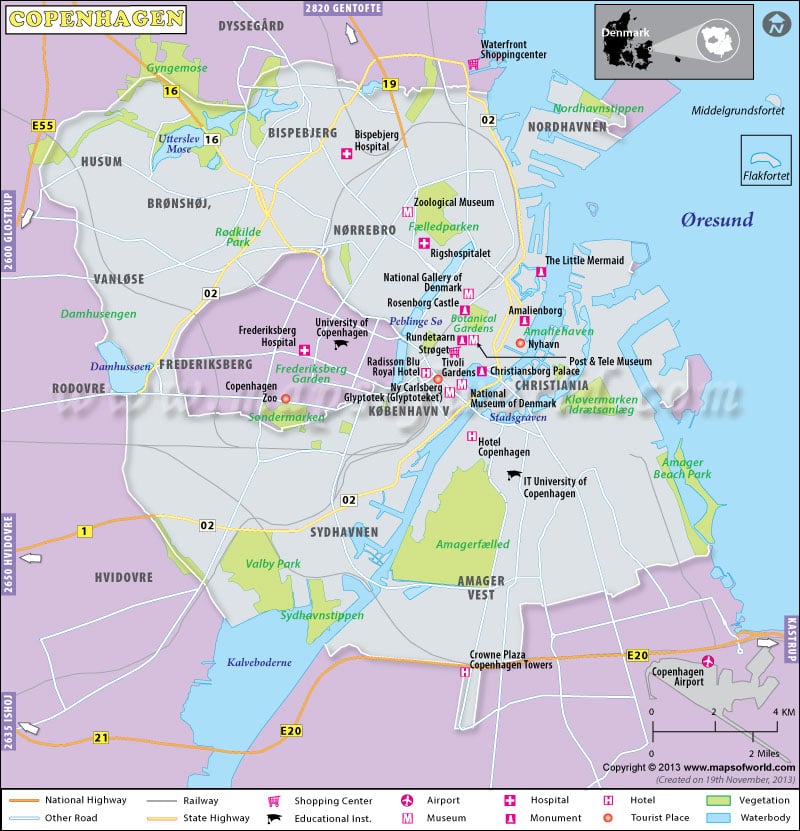About city
Copenhagen, the capital of Denmark is considered to be the most densely populated city. It holds an approximate metropolitan population of 1,967,727 and an urban population of 1,230,728. A wide array of tunnels and bridges binds the city together. Established in the 10th century, Copenhagen was formerly a Viking fishing village. Much later in the 15th century, it became the capital city of Denmark. With time, it has turned out to be an influential cultural and urban center, preferably because of the huge investments in infrastructure and cultural facilities.
Geography
Besides being the largest city, Copenhagen also carves a niche for being the national capital and chief port of Denmark. It is located on the eastern side of Zealand; the biggest Danish archipelago. Denmark lies on a low-lying platform and faces the Öresund (a narrow strait, which separates Sweden and Denmark).
Climatic conditions in Copenhagen are influenced by the North Atlantic current as well as the neighboring seas.
How to reach (transport)
Public transportation in this city is perhaps the most reliable and efficient in the nation. Besides, the government makes every possible effort to improve the transport infrastructure.
-
Bus :
Copenhagen is noted for its efficient bus system. It comprises routine buses and harbor buses. You can also avail night buses while making a travel to Copenhagen.
-
Airport :
Copenhagen airport is situated in zone 4, which implies that all buses, trains and metro will need an authentic ticket to enter the city from the airport.
-
Metro :
Copenhagen Metro is a convenient way to get around the city. Presently it comprises 2 lines and 22 stations. In due course of time, it is also anticipated that the city will come up with an additional 17 stations.
-
Trains :
The local trains connect the city to the various suburbs and other surrounding areas. It comprises 7 lines and 85 stations. A majority of them are connected to the bus and metro system of Copenhagen.
When to visit
Summers are the best time to plan a tour to Copenhagen. The city comes to life in the summer months of May to September; and tourists can witness a wide array of events and festivals during this point of time.
Culture (fairs and festivals) and traditions
Copenhagen makes a mark for being the largest festival city of northern Europe. Some of the important festivals celebrated here are as follows:
-
Copenhagen Festival Scene :
Globally recognized, this festival is noted for its influential cultural standards. Every year, it lures thousands of locals and visitors. The organizers too ensure to keep up the lively spirit by introducing new artists from Denmark and other countries.
-
Copenhagen Distortion :
To witness Copenhagen nightlife at its best, make sure to be a part of the Copenhagen Distortion. Formerly a small street festival, today it has turned out to be one of the biggest festivals in Copenhagen. With over 100,000 people enjoying at their best, this festival makes a mark for its fashion, nightlife, late-night chaos, community networks and hype.
- Copenhagen Cooking is the yearly Nordic Food Festival which lasts for about one week. Various mouth-watering palates from Denmark as well as other Nordic countries are served on this event. So, whether you want to please your taste buds with gourmet food or have a special corner for traditional dishes, this event is the perfect choice to count on.
- The city is also home to the renowned ballet festival, i.e. the Copenhagen International Ballet. This festival has come into existence since 1996 and is usually celebrated in the third week of August.
Points of interest (places to visit)
There is so much to see and do when in Copenhagen! Whether you want to take a stroll by the city or want to spend some hours in tranquility at the harbor, Copenhagen ensures to help you with all. Some of the must visit places here are as follows:
- Your trip to Copenhagen is incomplete without making a way to Tivoli. Tivoli makes a mark for its serene parks and innumerable activities for kids. In summers, it remains open everyday from 11 am to 10 pm. In fact, Copenhagen is famous for two amusement parks – Tivoli and Bakken; but then the charismatic appeal of the former surpasses all. It’s a 165-year-old establishment and located at the very heart of the city.
- Founded way back in 1888, Ny Carlsberg Glyptotek is a famous museum in Copenhagen, founded by Carl Jacobsen, a well-known brewing magnate. The museum houses a wide collection of Mediterranean art and French Impressionist paintings.
- The Stroget is one of the longest shopping streets in Europe. Those eyeing on the best bargain deals should start their shopping spree from Radhuspladsen ( end of the street). Here you are sure to get hold of simpler foods, lower prices and other affordable offers.
Accommodation
Comfort is something that we all eye on when it comes to planning a tour. After a long day of sightseeing, when we get back to our hotel, all we desire is a peaceful sleep; and to make this a true success Copenhagen promises to help you with the best stay options ever. Those who don’t mind spending when on a vacation, can plan their stay in great luxury at the Hotel D’Angleterre Copenhagen, The Phoenix Hotel of Copenhagen, The Radisson SAS Royal Hotel, Copenhagen FRONT Hotel, or Copenhagen Grand Hotel. On the other hand, if you are planning a tour on a tight budget, then plan your stay at affordable hotels including Somandshjemmet Bethel, Savoy Hotel, Hotel Cabinn City, and Wakeup Copenhagen.
